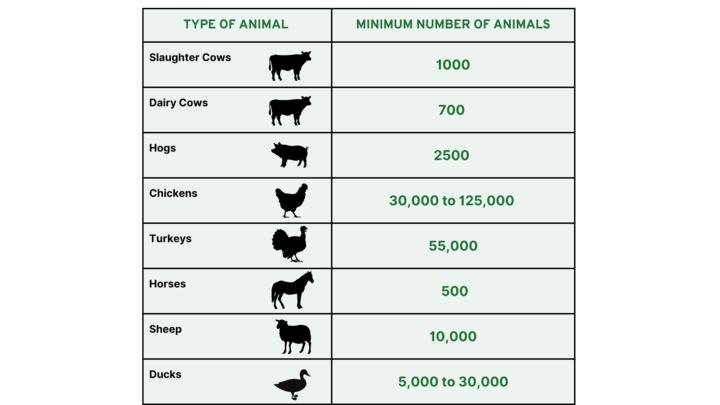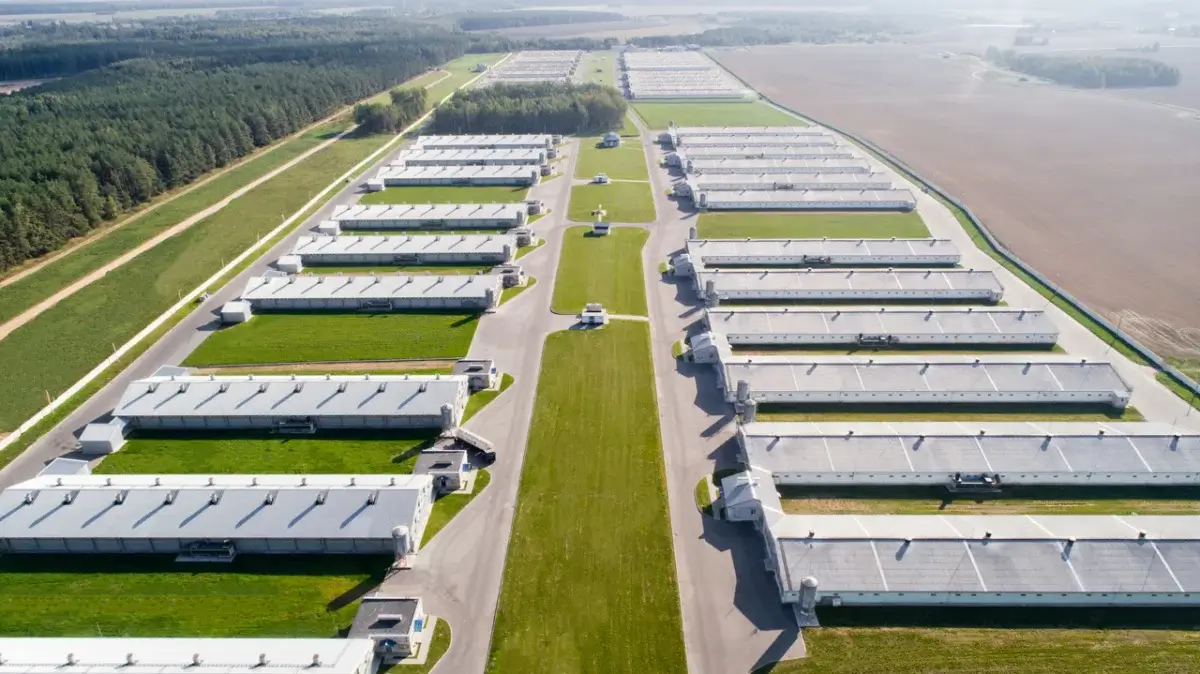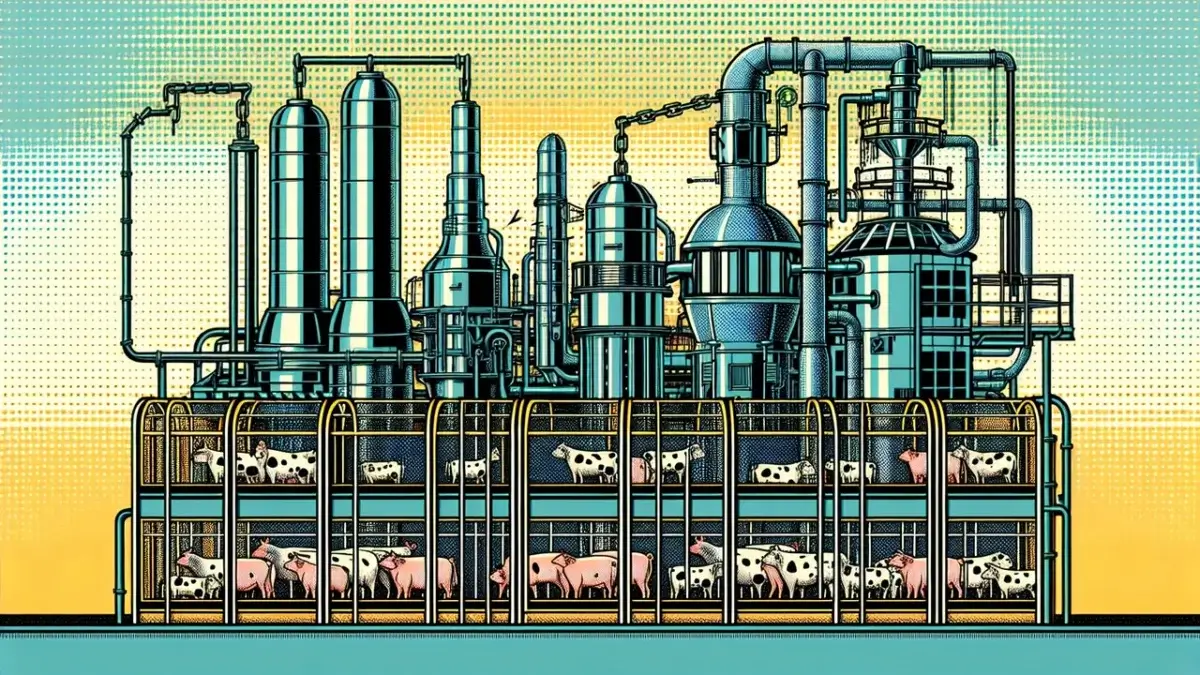Factory Farms Explained
What do people mean when they say, “factory farm”? Here’s a short breakdown, and why people want alternatives.
Chickens packed into spaces so small that many are unable to stand or walk. Birds panting due to overheating. Many have sustained injuries, and they all sit on a cake of fecal matter.
That’s how a farmer who used to work for Perdue described his chicken house—a sight so upsetting that it led him to transition out of this kind of work, often referred to as “factory farming.”
Factory farming is a colloquial term, one meant to evoke the mechanized and impersonal nature of the process—although the phrase itself is somewhat vague. How big of an operation are we talking about, and why is it a problem? To get at the heart of the issue, it helps to be more specific.
What the term is actually referring to can be more or less encapsulated in large-scale CAFOs, or concentrated animal feeding operations.
Concentrated animal feeding operations
CAFOs are defined by the EPA as intensive feeding operations where many animals are confined and fed for at least 45 days per year (though it can be much more) and inevitably their manure and waste come in contact with ground and surface water.
There are small, medium and large CAFOs, with the largest of these embodying the truest definition of a “factory farm.” A large CAFO is at least 1,000 “animal units. ”An animal unit is roughly 1,000 lbs of live animal so to be classified as a large CAFO an operation would need to have at least:

Or combinations of all types of animals totaling 1,000 animal units.
The largest of these CAFOs hold tens of thousands of animals in one place.
Rationalized as a way to feed more people, large CAFOs are pervasive in our food system. But industrial animal agriculture comes with a lot of downsides.

What’s the problem?
The main problems with concentrated animal agriculture are its impacts on human health, its impact on the environment, and its threats to animal welfare. Many of these issues can be boiled down to the fact that these operations produce a lot of manure in one place. And those pollutants are released directly into the air and water. A single large CAFO can produce as much waste as a human city but without the same sewage treatment processes in place.
Human Health
For people who live near these CAFOs, pollution of the air and water pose serious health concerns. Respiratory issues such as asthma can be caused or made worse, and nitrate pollution in water can cause conditions such as blue baby syndrome. Although it can be difficult to prove causation, there have been many instances of serious issues believed to be caused by living close to CAFOs, such as cancer, miscarriages, and more. In the US, research has indicated that the impacts of agriculture on air quality lead to 17,900 deaths per year.
Additionally, these large-scale animal operations are often built in communities of color. For example, in California’s Central Valley, people of color are 1.29 times more likely to live within three miles of a large dairy CAFO than white residents. With examples of this spanning the country, from California to North Carolina, this kind of pollution is a pattern of environmental injustice.
Farmer Health and Well-being
Often, the farmers who enter into contracts with big meat companies such as Tyson or Perdue find themselves taking on extensive debt to keep up with the equipment demands of the company. Due to the pay system that some of these companies use, farmers don’t make enough money to get out of debt. Instead, the company keeps the profits while the farmers shoulder the overhead costs. Ultimately, contract farming has caused many producers to lose their farms.
READ MORE
Find more stories of farmers transitioning out of contract farming here.
Environment
Air and waterways can be seriously polluted by CAFOs. In Iowa, the state with the most hog waste in the country, the number of polluted waterways has increased dramatically in the last few decades. In North Carolina, flooding caused by Hurricane Matthew had caused substantial pollution when hog waste overflowed from their lagoons. The reason CAFOs are designated by the EPA is because the Clean Water Act specifically regulates waste and pollutants in our water and this concentration of animals and their waste is seen as a major source of potential pollution.
Animal Welfare
In these operations, chickens, cows, and hogs are kept in conditions where they can hardly move or stand up. They are dirty and ill for most of their lives. Animal rights groups have long sounded the alarm on these conditions, but Ag-gag laws are in place in many states in an attempt to prevent these conditions from being documented.
LEARN MORE
Want to eat less meat but not sure where to start? Sign up for Vox’s Meat/Less newsletter course.
Additional Issues
Living near a large CAFO can impact people in a lot of other ways, too. There is an ever-present bad smell, flies, property values go down, mental health implications, and more. Even if you do not live next to a large CAFO, the issues with this type of animal production can include the spread of disease and strain on water supply.
No. Advocates would not equate large-scale CAFOs with farming at all. There are many farms—farms that practice animal agriculture—that operate in a way that protects the environment, practices responsible animal care, and does not harm the human communities close to them. These farmers are in a different category from industrial animal agriculture, which many farmers and advocates in this space would say is actually not agriculture at all, but more similar to manufacturing—hence the “factory” moniker.
Still, this industry will often present itself as representative of the American farmer. As a result, critics are branded as “anti-agriculture” when in fact, the opposite is true. What many advocates call for is not the end of farming, but the end of a brand of food production that harms more than it helps.
Connect with experts
“When you have too many animals in one place, you’re going to have too much waste in one place, and that waste becomes a problem—that waste becomes a pollutant,” says Chris Hunt, Deputy Director of Socially Responsible Agriculture Project (SRAP). Modern Farmer’s reporting is strengthened by the expertise of organizations like SRAP.
Follow us
This work is licensed under a Creative Commons Attribution-NoDerivatives 4.0 International License.
Want to republish a Modern Farmer story?
We are happy for Modern Farmer stories to be shared, and encourage you to republish our articles for your audience. When doing so, we ask that you follow these guidelines:
Please credit us and our writers
For the author byline, please use “Author Name, Modern Farmer.” At the top of our stories, if on the web, please include this text and link: “This story was originally published by Modern Farmer.”
Please make sure to include a link back to either our home page or the article URL.
At the bottom of the story, please include the following text:
“Modern Farmer is a nonprofit initiative dedicated to raising awareness and catalyzing action at the intersection of food, agriculture, and society. Read more at <link>Modern Farmer</link>.”
Use our widget
We’d like to be able to track our stories, so we ask that if you republish our content, you do so using our widget (located on the left hand side of the article). The HTML code has a built-in tracker that tells us the data and domain where the story was published, as well as view counts.
Check the image requirements
It’s your responsibility to confirm you're licensed to republish images in our articles. Some images, such as those from commercial providers, don't allow their images to be republished without permission or payment. Copyright terms are generally listed in the image caption and attribution. You are welcome to omit our images or substitute with your own. Charts and interactive graphics follow the same rules.
Don’t change too much. Or, ask us first.
Articles must be republished in their entirety. It’s okay to change references to time (“today” to “yesterday”) or location (“Iowa City, IA” to “here”). But please keep everything else the same.
If you feel strongly that a more material edit needs to be made, get in touch with us at [email protected]. We’re happy to discuss it with the original author, but we must have prior approval for changes before publication.
Special cases
Extracts. You may run the first few lines or paragraphs of the article and then say: “Read the full article at Modern Farmer” with a link back to the original article.
Quotes. You may quote authors provided you include a link back to the article URL.
Translations. These require writer approval. To inquire about translation of a Modern Farmer article, contact us at [email protected]
Signed consent / copyright release forms. These are not required, provided you are following these guidelines.
Print. Articles can be republished in print under these same rules, with the exception that you do not need to include the links.
Tag us
When sharing the story on social media, please tag us using the following: - Twitter (@ModFarm) - Facebook (@ModernFarmerMedia) - Instagram (@modfarm)
Use our content respectfully
Modern Farmer is a nonprofit and as such we share our content for free and in good faith in order to reach new audiences. Respectfully,
No selling ads against our stories. It’s okay to put our stories on pages with ads.
Don’t republish our material wholesale, or automatically; you need to select stories to be republished individually.
You have no rights to sell, license, syndicate, or otherwise represent yourself as the authorized owner of our material to any third parties. This means that you cannot actively publish or submit our work for syndication to third party platforms or apps like Apple News or Google News. We understand that publishers cannot fully control when certain third parties automatically summarize or crawl content from publishers’ own sites.
Keep in touch
We want to hear from you if you love Modern Farmer content, have a collaboration idea, or anything else to share. As a nonprofit outlet, we work in service of our community and are always open to comments, feedback, and ideas. Contact us at [email protected].by Lena Beck, Modern Farmer
August 12, 2024
Modern Farmer Weekly
Solutions Hub
Innovations, ideas and inspiration. Actionable solutions for a resilient food system.
ExploreExplore other topics
Share With Us
We want to hear from Modern Farmer readers who have thoughtful commentary, actionable solutions, or helpful ideas to share.
SubmitNecessary cookies are absolutely essential for the website to function properly. This category only includes cookies that ensures basic functionalities and security features of the website. These cookies do not store any personal information.
Any cookies that may not be particularly necessary for the website to function and are used specifically to collect user personal data via analytics, ads, other embedded contents are termed as non-necessary cookies.

released directly into the air and water? That was I Allie.
I live in High River, Alberta, Canada. A community of some 14,000 folks, many retired. Our government chose to allow a CFO of some 50,000 cattle upwind of us and we are constantly bombarded by the stink and dust.
We are fighting to stop the construction of North America’s largest biodigester next to the feedlot. Some 110 acres with a 20.7 acre open digestate pond.
http://StopThatSmell.ca
How is this acceptable in any environment. Big business has targeted our beautiful town near the Rocky Mountains and I fear for our future.
What research has been done on the cost/benefit of not allowing any CAFO’s? What would be the effects in terms of environment, food cost, land use, etc?
The major complaints about CAFO operations are often the odor and water pollution. Both of these can be handled on the farm with simple procedures that are both effective and economically sound. Odor travels on dust. Lining the farm property with pine trees will capture an amazing amount of dust/odor. Also, since people tend to smell with their eyes, if the farm in not visible, it tends to smell less. Water contamination is related to odor as well as environmental degradation. While containing runoff is the common solution today, it does little to mitigate ammonia and other issues. There is… Read more »
Factory Farms are coming up mainly to save labour or in other words where sufficient (cheap) labour is not available. Agriculture should always be considered as labour intensive activity which will also solve the problem of ever growing population around the world.
I would like to see a artical that was written by someone who was on a farm on what they saw and experienced. I think their writing would be differant than they heard from from someone